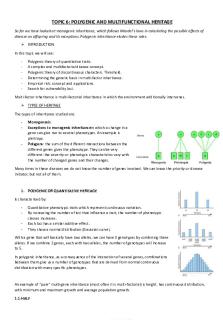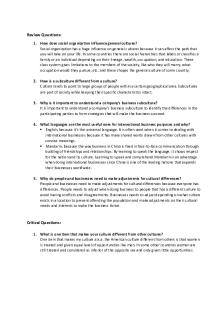Unit 6 Gradpoint Questions PDF

| Title | Unit 6 Gradpoint Questions |
|---|---|
| Author | Olivia Jones |
| Course | Inter Forensics |
| Institution | Shepherd University |
| Pages | 2 |
| File Size | 28.4 KB |
| File Type | |
| Total Downloads | 52 |
| Total Views | 143 |
Summary
Imagine that you are at a crime scene. You find skeletal remains, but the skeleton is not complete as some of the smaller bones are missing. The bones are within a twenty feet radius. Based on this information, what would you be able to ascertain about the time of death and the individual who was ki...
Description
Review Questions 1. What is liver mortis? How might this reveal information about the time of death? Liver mortis is another change that forensic scientists may find. This refers to the settling of blood in the lowest parts of the body. When the heart stops beating and pumping blood through the body, the blood accumulates and pools in whatever part of the body is closest to the ground. For example, a body found lying face up, might show signs of the blood pooling in the back. The areas where the blood accumulates may have a dark blue or purple discoloration of the skin. This process begins soon after death and reaches its maximum at about 8 to 12 hours after death. 2. What three aspects does a forensic autopsy seek information about? Describe each of these aspects? The cause of death is the medical problem that leads to death, such as blunt force trauma, internal bleeding, blood loss, or gunshot. The mechanism of death refers to any instrument or weapon used in a death, such as a knife or firearm. The manner of death for a forensic autopsy is often suicide or homicide, as opposed to disease or other natural causes. 3. How can digestion rates give information to forensic scientists about the time of death? The process of digestion can also aid investigators in determining the time of death. When someone dies, digestion of any food eaten ceases. Forensic pathologists can use this information during an autopsy, discussed later in the unit, to see how far along the digestive process food has traveled. It takes about 10 minutes for food to begin moving from the stomach to the intestines. The size of the meal and where it is in the digestive process can help indicate the time of death. Light meals typically take about 1 to 2 hours to digest fully in the stomach. Medium meals take about 3 to 4 hours and heavy meals can take up to 6 hours. The type of food eaten also has to be taken into consideration, as liquids will digest faster than solid foods. 4. What is mummification? Mummification is a drying of the body and its tissues. The body and skin can take on the appearance and texture of leather and the process can happen within a matter of days. 5. How can human bones give forensic scientists an indication of age? Describe some of the aspects that would give this information. Determining the age of the individual becomes harder the older the individual was. In general, the age of children's remains can be identified to within a year or two of their age at the time of death. The length of the long bones and the teeth present are usually used to age the bones of children. For adults, the wear on permanent teeth can give forensic scientists the age of a person within ten years, although the wear can vary depending on the type of foods eaten by the person during their lifetime. The condition of the bones may
also give forensic scientists an idea of the person's age, with arthritis or wear in the joints suggesting a greater age than bones without this. Some studies have suggested that using the physical appearance of bones to give the age of a person at the time of death can produce inaccurate results. These studies suggest that perhaps the best estimates are those separating the age of an individual into broad categories, such as young adult, middle aged, and elderly.
Critical Thinking Questions 1. Imagine that you are at a crime scene. You find skeletal remains, but the skeleton is not complete as some of the smaller bones are missing. The bones are within a twenty feet radius. Based on this information, what would you be able to ascertain about the time of death and the individual who was killed? You would be able to tell how old they were, what sex they were, and based on the decay where they were killed (if moved) and when they were killed. I would guess that these bones have been moved over time. Or they may have been killed by an animal, that carried away parts of their body. 2. Out of the different methods to help determine the time of death, which one do you think is most effective? Why? Rigor mortis begins after two hours of death, starting from the head and slowly progressing to the feet. 3. Do you think you would like to participate in an autopsy? Why or why not? Yes, they seem interesting. 4. If you were a forensic anthropologist and were studying human remains, what information would you look for in the bones? Why would this information be helpful? I’d look for the age, sex, ethnicity, height, time since death, and trauma. This is helpful because it helps you identify. 5. What can the distribution of bones tell a forensic scientist? What do you think would be the most challenging aspect of collecting skeletal remains at a crime scene? The distribution of the bones can help investigators get an estimate of the time of death.The most challenging aspect would be collecting all the bones since the human body has 270 bones when we are born...
Similar Free PDFs

Unit 6 Gradpoint Questions
- 2 Pages

Unit 6 Reading Questions
- 2 Pages

Unit 6 text questions
- 2 Pages

Worksheet 6-Unit 6
- 1 Pages

Unit 6 - Lecture notes Unit 6
- 1 Pages

Unit 6 lab - Unit 6 lab
- 1 Pages

Unit 06 - Unit 6 notes
- 3 Pages

Unit 6 - Unit study guide
- 4 Pages

Unit 6 - Lecture notes 6
- 7 Pages

Self-Test 6 - Unit 6
- 4 Pages

Unit 6 - Lecture notes 6
- 5 Pages

Unit 6 - Written Assignment
- 4 Pages

ENERGY FLUX. UNIT 6
- 6 Pages
Popular Institutions
- Tinajero National High School - Annex
- Politeknik Caltex Riau
- Yokohama City University
- SGT University
- University of Al-Qadisiyah
- Divine Word College of Vigan
- Techniek College Rotterdam
- Universidade de Santiago
- Universiti Teknologi MARA Cawangan Johor Kampus Pasir Gudang
- Poltekkes Kemenkes Yogyakarta
- Baguio City National High School
- Colegio san marcos
- preparatoria uno
- Centro de Bachillerato Tecnológico Industrial y de Servicios No. 107
- Dalian Maritime University
- Quang Trung Secondary School
- Colegio Tecnológico en Informática
- Corporación Regional de Educación Superior
- Grupo CEDVA
- Dar Al Uloom University
- Centro de Estudios Preuniversitarios de la Universidad Nacional de Ingeniería
- 上智大学
- Aakash International School, Nuna Majara
- San Felipe Neri Catholic School
- Kang Chiao International School - New Taipei City
- Misamis Occidental National High School
- Institución Educativa Escuela Normal Juan Ladrilleros
- Kolehiyo ng Pantukan
- Batanes State College
- Instituto Continental
- Sekolah Menengah Kejuruan Kesehatan Kaltara (Tarakan)
- Colegio de La Inmaculada Concepcion - Cebu


